Let’s dive straight into some ideas on how you can motivate more of your existing customers to shop again.
There are 3 core objectives to your work in ecommerce marketing.
One, acquiring new website visitors. To drive quality traffic to our websites.
Two, conversion optimisation, to convert as many of those visitors into customers as you can.
Three, building retention, to motivate as many of those customers to shop again and again.
I want to focus on the latter with you. How we build customer loyalty and motivate more customers to shop again. I want to share with you what I’ve learned as both a practitioner and consultant growing ecommerce brands over the past 20+ years.
A QUESTION TO CONSIDER
If all of our attention is on new customer acquisition are we shackling profitable sales growth?
This is something I’m seeing over and over again. The vast majority of time and money is spent looking at new ways to drive traffic to our websites. New ways to motivate people to shop. New opportunities to put offers and discount codes into the hands of our customers. And yet, in the background there’s a database of 1000, 10000, 100,000 existing customers where with a little bit of time and focus you could be making a lot more money for your ecommerce business.
THE DATA AS EVIDENCE
Getting buy-in was seen as one of the biggest challenges faced when Forbes reviewed the state of retention a few years ago.
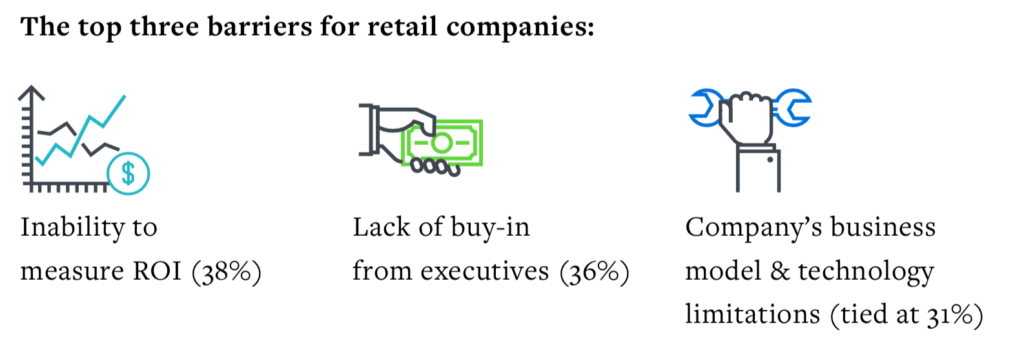
There’s been a range of analysis on the impact of a concerted effort to drive customer retention. Adobe, back in 2012, published a report looking at millions of transactions from 5000+ retailers seeing that the repeat website customer is worth, typically, 5 times as much to you when they land on your website as a new visitor.
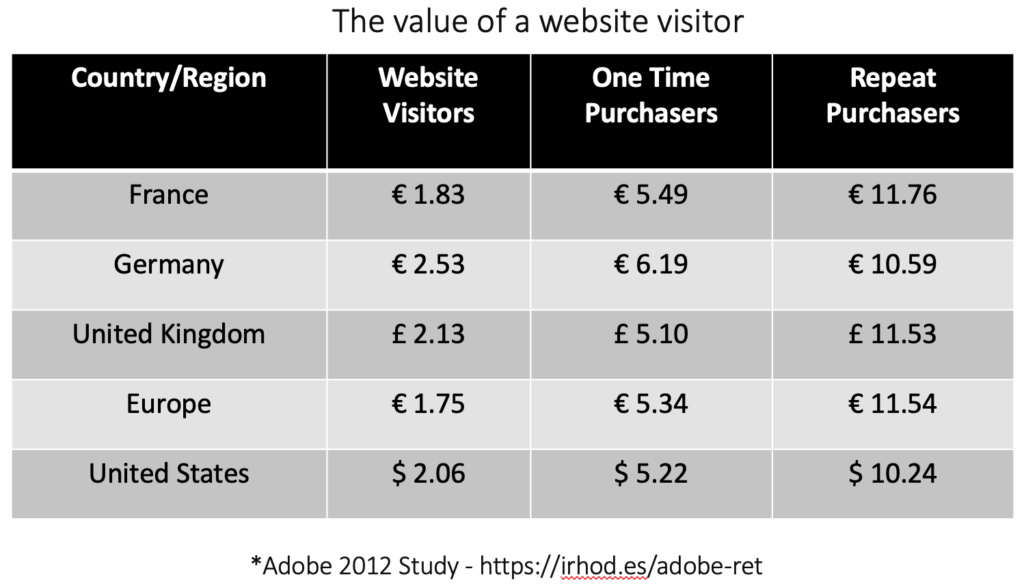
Furthermore, the costs to get that customer back to your site are far far less than the investment in bringing new visitors to your site through paid search and social.
One of the main reason’s ecommerce brands aren’t investing in retention marketing is the lack of buy-in from the very top. Presenting these numbers and demonstrating the impact retention strategy can have on your business will help you to bring greater focus to retention and loyalty marketing
WHAT ARE YOU DOING TO RETAIN MORE CUSTOMERS?
The old value proposition of fast delivery, great prices and easy returns is now the norm. In the world of Amazon we have to do so much more to give people a reason to come back and shop with us again and again.
A lot of my work involves auditing the overall performance of ecommerce marketing strategies. The vast amount of that time is spent looking at new visitor acquisition. I want to focus in on retention. Asking key questions to get a better understanding of just how customer retention can be taken seriously and be managed correctly to build a real driving force for ecommerce growth.
THE ECOMMERCE MARKETER’S RETENTION DEFAULT
This is something I’m seeing more and more. The tactic of ‘win-backs’. Sending out emails to lapsed customers at certain intervals. You’re consumers, you’ve seen them yourselves. ‘Hey, we haven’t seen you around for sometime. Here’s a coupon code. Come on back.’

This particular win-back attempt was sent a year or so after I ordered my son a Thomas the Tank Engine poster. I’m presented with 4 completely random products and given a 10% discount code on a purchase that will probably cost me 5 or 10 pounds. Is that real incentive? This isn’t retention marketing. It’s a tactic that needs significant work in order to motivate people to come back and shop. Especially for companies where there’s a low average order value and a high probability of repeat purchase, actioning a clear customer retention strategy is crucial.
So that’s the background. The reasons why we need to focus on retention. Let’s now move on to the ‘how to’.
3 FOUNDATIONS OF A DAMN GOOD RETENTION STRATEGY
There are 3 core foundations to your work in customer retention. Customer behavioural data, a brilliant onboarding series and personalised communications.
These foundations apply to any sized business. For startups, it’s crucial to work to a retention mindset – understanding the future value of a new customer. For established brands where you’re hitting a ceiling with your work in acquisition, there’s significant money to be made focusing in on your existing customer database.
This work isn’t as time consuming as you might expect – once you’ve laid the foundations.
So let’s run through these 3 key areas one by one.
1.) DATA – USABLE, ACTIONABLE, CONSISTENT DATA
Firstly, data. The data’s a little different to what you’re working with within Google Analytics. We’re now looking at the purchase data that you’ll find within your ecommerce platform – shopify, magento, demandware and extracting insight in terms of customer behaviour and buying patterns.
This all links to making your marketing more profitable. The idea is that the more someone buys from you and the more often someone buys from you the more efficient it becomes to run your business.
WHAT’S GOING ON UNDER THE FUNNEL?
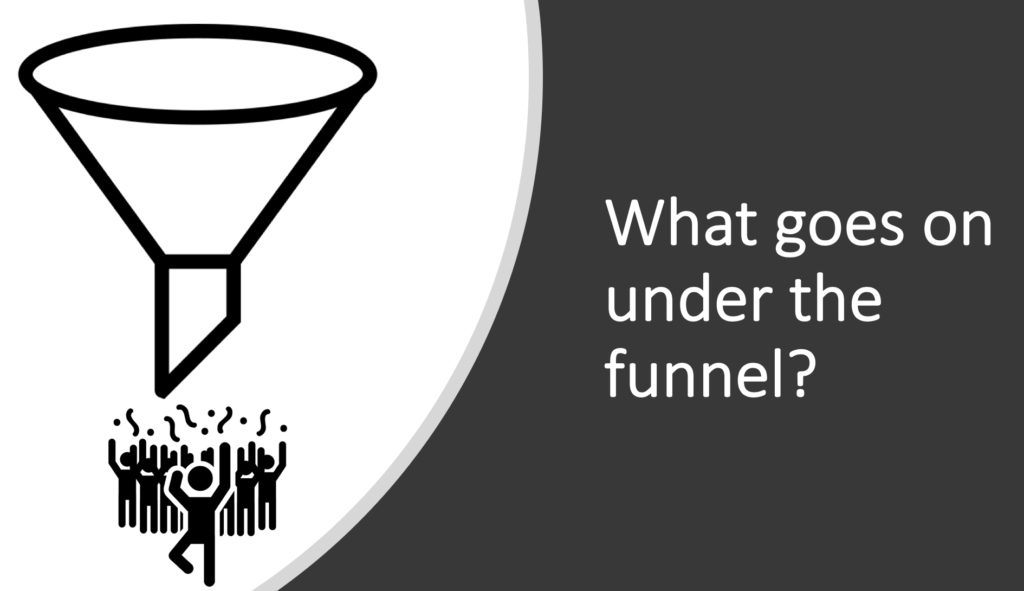
When we start looking at what happens under the funnel we begin to understand a little more about our buyers. We’re learning how often people buy, how soon people buy and how much they spend. A lot of work is based around the RFM model – a multiplier of the recency, frequency and monetary value. It begins to give us a greater understanding of who are ideal customers are.
INTRODUCING CLV (Customer Lifetime Value)
What we’re looking to achieve is a fuller understanding of the customer lifetime value to our business. Knowing how much somebody spends, not just on the initial purchase, but throughout their buying, dictates how much we’re prepared to spend to earn that customer in the first place.
In it’s simplest form, it’s the multiplier of the average order value x average purchase frequency. There are 2 key metrics. Historical CLV (how much people have spent) and Predictive CLV (understanding how much more that person may spend).
HOW CLV CAN BE USED
This isn’t about one simple formula. CLV can be used to analyse a whole range of customer segments. You’ll discover the impact of discounting, you’ll learn which products are great introductions to your brand where people go on to make more purchases.
Crucially, you’ll see the impact of your work in traffic acquisition. The variance between shoppers that find you through Google Ads campaigns, social media, referrals. As everything is linked to the individual customer you’re opening up a whole new range of knowledge as to which products to push and through which channels.
KEY MARKETING TECHNOLOGY TO LEARN CLV: GLEW
Understanding customer data isn’t all about excel spreadsheets. Similarly, understanding website data isn’t all about reading through data logs. There are some fantastic tools on the market that can help you consolidate data and build workable insights.
There are a range of enterprise tools that bolt straight into your ecommerce platform. My personal favourite is Glew.io. Glew does two things. Firstly, it presents the data in an easy to visualise format – you can see product by product and category by category, the impact of repeat buyers upon your business. More importantly it gives you workable segments that you can integrate with your email platform or Facebook audiences.
Okay, so now we have the data let’s see how we can put it to use to drive retention growth.
2.) THE POST-PURCHASE EXPERIENCE
The second part of the audit – we’re now going to look at the post-purchase experience. How you communicate with your customers once they have completed their order.
At this stage it’s typically very transactional – the order receipt, the dispatch confirmation, then the updates from couriers and it all starts to get a little messy. We need to be asking if we’re doing everything we can to put our customers mind at ease. We don’t want to bombard them, but what we do want to do is provide them with timely relevant information.
Post-sales emails will typically see far higher open rates than your regular communications. With that in mind, let’s make the very most of the moment when our customers are ready and expecting to hear from us.
WELCOME YOUR CUSTOMERS TO ‘THE CLUB’
I love the idea that you’re not building a customer database, you’re building a club. It’s your job to make sure that your club members are made to feel welcomed.
This is your real opportunity to cement a bond with your brand and take the conversation a little more one-to-one.
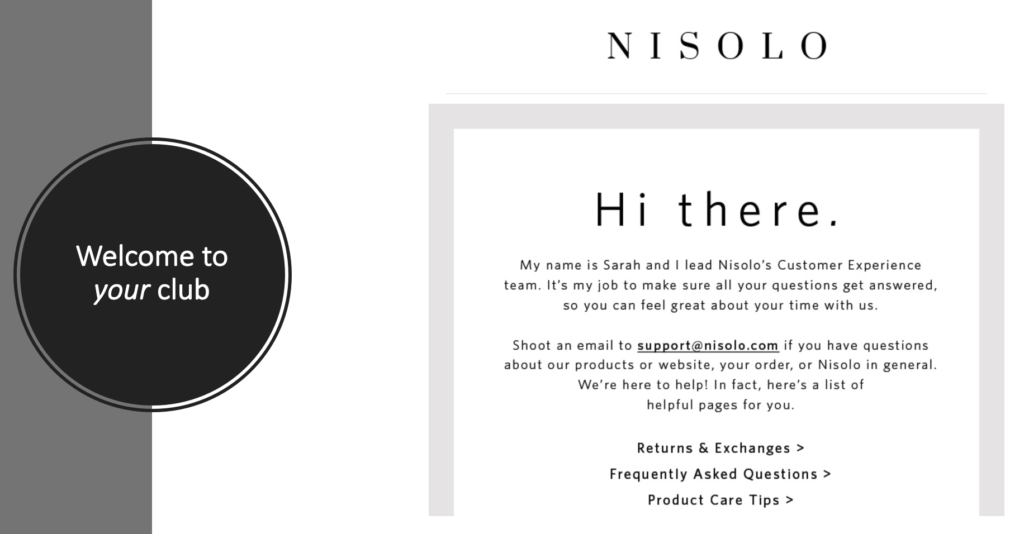
Here’s a great example from Nisolo. A simple email that introduces a key member of staff who is there to help your customer with any questions they may have. This is brilliant for first time customers who may be feeling a little anxious as to when they’re receive delivery of their products.
However, what we often do is send out a default email no matter who’s buying. Take an example of a 2nd time purchaser. These are the people that we need to be truly showing our appreciate for.
It’s like when you walk into your favourite restaurant. It’s a great feeling when the waiter welcomes you by your name and remembers your favourite meals. It’s our job as ecommerce marketers to present that situation in the online world.
Recognition is the keyword here. Recognising the needs of first time and repeat customers. It’s not a difficult task but it is a task that’s crucial to your onboarding success with all customers.
GET MORE REVIEWS BY ASKING THE RIGHT QUESTIONS
A week or so since your customer has received their order, you’re probably sending a review request.
This isn’t a request for a pat on the back from your customer. There’s a big opportunity here to give your customer the chance to really consider their purchase and to feedback to you.
Make that subject field as crystal clear as you can. Don’t lead with ‘did we do well?’ or ‘would you recommend us’. Reviews are a pivotal part of your social proofing and help tremendously in your conversion tactics. With platforms such as Yotpo you can make your questions far more relevant to the customer too. Again, the opportunity that exists here is to get people to stop and think about the value your brand has delivered to the.
Put a lot of consideration into what will motivate people to leave feedback.
INTRODUCING THE PRODUCT CATALOGUE
This is a great little email that I see a lot of brands missing out on because they assume their customers know what they do.
Think about your own online buying. Especially when it’s a product or category that you haven’t purchased in the past. You’re specific in the problem you’re looking to solve. We rarely wander away from the category we’re searching within.
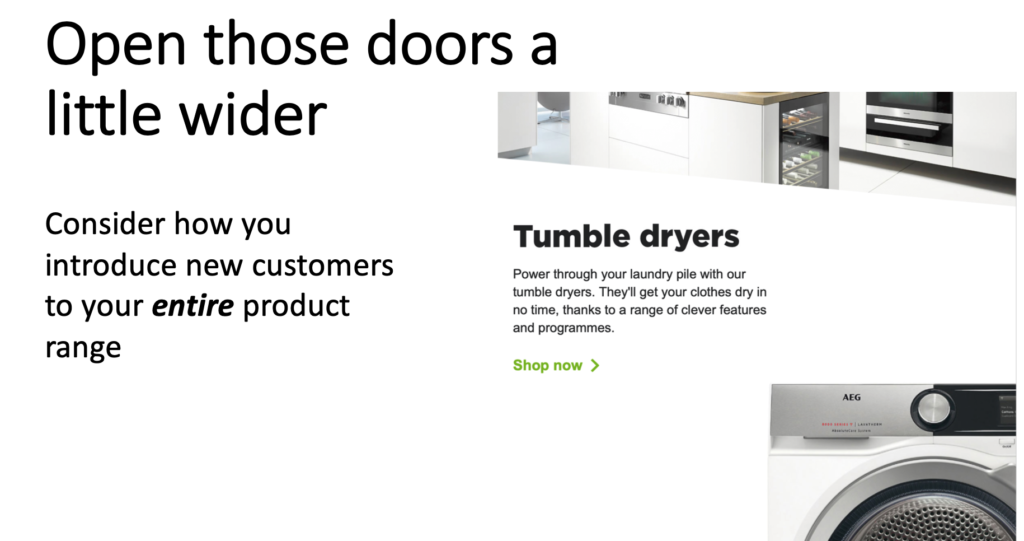
Sending out an email 1-2 weeks after a purchase is made that gives people an understanding of the depth of products you offer is a great way to introduce new products. Don’t forget that everything your customer clicks is trackable.
Here’s a great example from AO.com. I had the fun duty of purchasing a new washing machine. I had nothing else on my mind (for a few moments) than to replace that tin contraption. However, the ‘here’s what else we do..’ that AO.com sent me was directed to me as a washing machine buyer. They weren’t pitching me more washing machine offers, they were introducing their best selling categories. If I’ve clicked on the ‘Ovens’ link you’d want to ensure that within your CRM that ‘interest’ has been linked to my account.
RECOMMENDED EMAIL PLATFORM: KLAVIYO
I’ve implemented dozens of retention strategies using Klaviyo. Klaviyo allows you to build segments with ease and target specific email campaigns to a cluster of customers where you’ll see the best return. If you aren’t already using Klaviyo I highly recommend taking their demo for a spin… If you’re already a Klaviyo customer I’m sharing weekly updates to help you get the most of their email marketing platform in my newsletter (subscribe at the footer of this article)
3.) THE ART OF PERSONALISATION
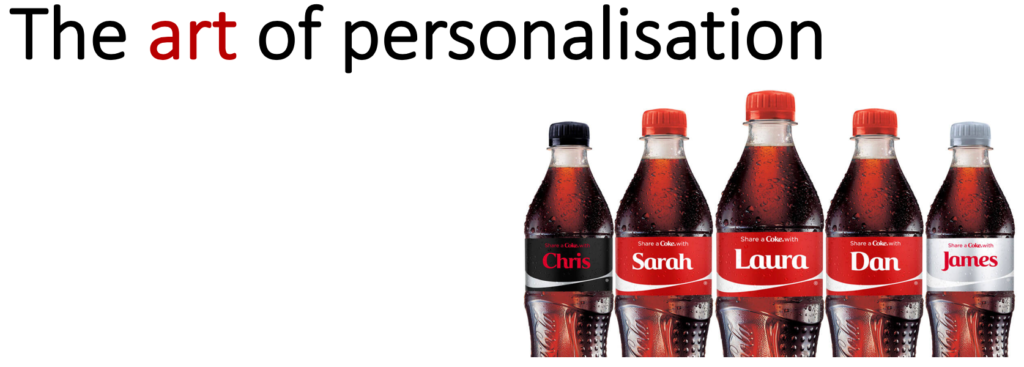
The third and final foundation I want to cover with you is the art of personalisation. Personalisation is a buzz word around the ecommerce world but it’s one where, as marketers, we’re really struggling to come to terms with how we personalise the customer experience. It’s not about introducing your emails with ‘Hey Jeff’. It’s about giving people what we believe they want from us. Again, this is mainly down to a lack of data that’s informing us of what we need or should be doing to make our customers’ experience with our brand feel a lot more centred around our customer.
BEHAVIOUR-TRIGGERED EMAILS
One advance in technology that I’m not seeing enough use of is the behaviour-triggered email. When your customer takes an action that automatically triggers an email response from you. Take as an example a recent email I received from Nomad. These guys make fantastically robust travel essentials for apple macs and iphones.

I’d clicked on an email they’d sent me and I looked at a product a couple of times. I was tempted, but not quite over the line.
An hour later, Chuck from Nomad emails me. He tells me about how he has just been hiking to road-test the cables. He loved them. In fact, he loved them so much he wanted me to buy one too – and he sends me a personal 10% discount code.
This again brings marketing down to a one-to-one level. We should use behavioural triggered emails sparingly but consider it the same as somebody in a bricks and mortar store checking out a product and scratching their chin in consideration. Our job is to walk up and help them build trust that that particular product is right for them. That’s what Chuck did with his email. You should try the same.
MAKE BETTER USE OF CLV SEGMENTS
CLV segments aren’t there to be simply analysed and reported upon. They allow us to create specific customer segments that we can better target too. It makes it so much easier to tailor our message when we know just who we’re writing that message for. To bring products properly into context. To remind people of how they’ve picked up a great deal with their previous coupon code or to
This is about making data actionable. The segments you use are specific to your own business. But as you begin to dig deeper into your predictive data patterns will start to emerge in terms of what people shop for next and the timescales. It will give you a better understanding of when to target customers and what with.
We’re not doing enough to make better use of the data that is available to us to up-sell and cross-sell or introduce new products to targeted segments of existing customers.
START PROPERLY REWARDING YOUR VIPs.
This is a biggie. If I asked your very best customers if they felt valued by your brand, what would they say? Would they admit to being a VIP?
If not, we have some work to do. The old pareto law kicks in with the assuming that 20% of your customers deliver 80% of your revenue. This is something we can either prove or disprove through a better understanding of customer purchase data. No matter what size your business is there will be significant chunk of cash in your business bank account down to the buying habits of a surprising few. I want you to let these people know they’re appreciated.
It’s not difficult. With the smarter email platforms, you can change the header imagery on each email sent to a particular segment. You can include blocks of text that only show to specific people. You can present offers to only specific people. You can tailor your newsletter to your VIPs without taking on a huge chunk of work. These are your most loyal and the people that create word of mouth around your brand. You have to form a bond with these people so that you retain their loyalty. Build a tier to your loyalty programme that’s only accessible to your top 10 or 20% of customers.
SUMMARY – KEY TAKEAWAYS
There’s a lot more to retention marketing and obviously the experience that takes place on your website is one that makes good use of data and personalisation. We haven’t covered that today.
We have covered what you can start doing right now using a few good tools and a retention strategy aligned to your email marketing.
To make this happen I want you to consider how much time and effort you are placing into retention marketing. I want to present you 4 actionable areas you can get to work on right away.
- To be data-informed and insight-driven. It’s not all about customer acquisition. There’s a lot of money to be made focusing in on motivating more existing customers to shop again.
- Really get to know your data. Use a platform, like Glew, that gives you usable segments that can improve your email or social media targeting.
- Create a welcome sequence better than any other on the planet.
- And personalise. Personalise. Personalise.
Retention marketing offers a huge opportunity to drive growth for your ecommerce business. Consider your working week and how much effort/analysis/work takes place learning how you keep more customers. When we’re looking at our acquisition datapoints and struggling to understand how to drive growth consider that list of existing customers. The people happy to purchase again if you give them a good reason to buy.

